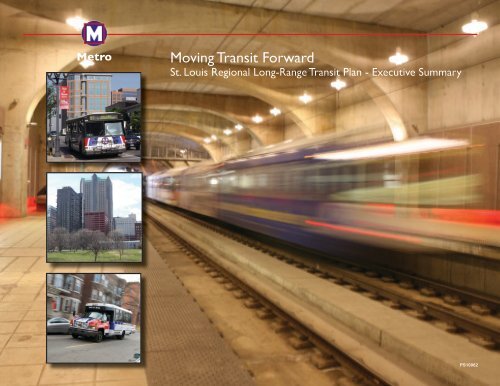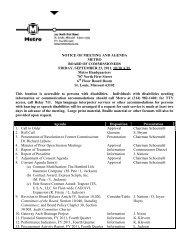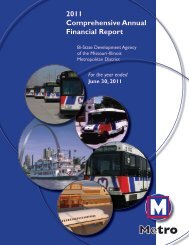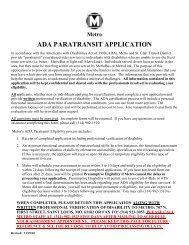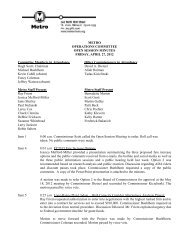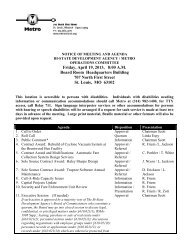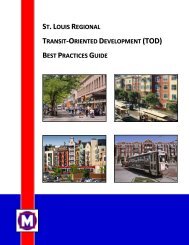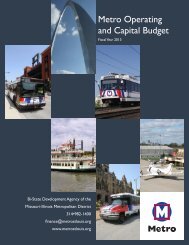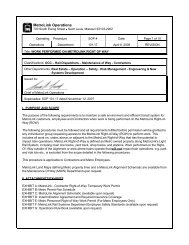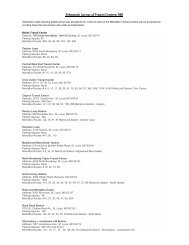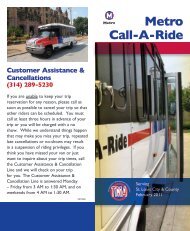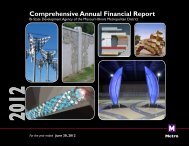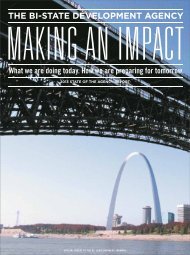Executive Summary - Metro Transit
Executive Summary - Metro Transit
Executive Summary - Metro Transit
- No tags were found...
Create successful ePaper yourself
Turn your PDF publications into a flip-book with our unique Google optimized e-Paper software.
<strong>Metro</strong>Moving <strong>Transit</strong> ForwardSt. Louis Regional Long-Range <strong>Transit</strong> Plan - <strong>Executive</strong> <strong>Summary</strong>PS10062
St. Louis Regional Long-Range <strong>Transit</strong> PlanMoving <strong>Transit</strong> ForwardMessage from the President and CEOFor the first time, the St. Louis metropolitan area has a long-range plan that presents acomprehensive vision for the future of public transit over the next 30 years.As President and CEO of <strong>Metro</strong>, I am pleased to provide you with a copy of the executivesummary from Moving <strong>Transit</strong> Forward, the plan we believe presents a realistic andresponsible road map that our region can follow in its endeavor to build a world-class publictransit system.This plan was developed over more than a year of consistent study and effort by <strong>Metro</strong> andthe East-West Gateway Council of Governments. It combines state-of-the-art transit science,professional urban and transit planning experience, and direct input from the community toreposition the <strong>Metro</strong> System to better connect people to jobs and other importantdestinations, and to act as a powerful engine of economic growth and developmentthroughout the region.Moving <strong>Transit</strong> Forward establishes a shared community vision to meet those goals, basedupon a realistic appraisal of our region’s public transit needs over the next three decades, themost effective options to meet those diverse needs, and the financial resources available topursue recommended system improvements and expansion options.The plan incorporates the proven strengths of bus, light rail and paratransit service strategies,as well as innovative concepts new to St. Louis, such as Bus Rapid <strong>Transit</strong> and commuterrail. It balances the very real need for a stronger, more extensive transit system againstavailable economic resources. It provides the region’s leadership with the vision and the toolsto overcome the significant challenges <strong>Metro</strong> faces in delivering the kind of robust transitservices we need to make the St. Louis a region a more vibrant community and a morecompetitive force in the global economy. Ultimately, Moving <strong>Transit</strong> Forward will betterconnect all our citizens to jobs, education, healthcare, commerce, and to each other.We believe Moving <strong>Transit</strong> Forward can be a valuable asset as we work together to meet ourregion’s transit needs in the months and years ahead. PDF copies of the full plan documentare available for download at www.movingtransitforward.org.Sincerely,Robert J. BaerPresident and CEO
<strong>Metro</strong> <strong>Transit</strong> and East-West Gateway Council of Governmentsworked with the community to create this blueprint for transit in theSt. Louis region over the next 30 years. Moving <strong>Transit</strong> Forwardestablishes a vision for more effectively using transit to:✦✦Move tens of thousands of people to work every day✦✦Stimulate job growth and economic development✦✦Reduce pollution and traffic congestion✦✦Improve the quality of life for all citizens, whether theyuse the system or notMoving <strong>Transit</strong> Forward is also a strategy for using different typesof transit to strengthen the region’s core, expand high-quality, highspeedtransit service to more parts of the region, and better connectpeople to jobs. Planned investments include restoring transitservices eliminated in 2009, enhancing the <strong>Metro</strong> System to makeit more attractive and accessible to residents across the region, andexpanding rail and higher-speed bus service.Moving <strong>Transit</strong> Forward is a financially reasonable plan. It suggestsphasing projects over the next 30 years, depending on availablefunding. Projects are divided into three achievable phases: a shortrangecomponent that outlines investments like service restoration,system enhancements, and initial design over a 1-5 year period;project construction and expansion over a 5-10 year period; andfurther options for expansion over the next 10-30 years.Moving <strong>Transit</strong> Forward presents a dynamic community vision,a living document that can be revised as the region changes. Itssuccess, however, depends on additional federal and state funding.Why is transit important?Great cities have great transit systems. The St. Louis region is awonderful place in which to live, work, and play, but in recent decadesits population and job growth has stagnated. To change this, theregion must move forward and boldly redefine itself as a catalyst forentrepreneurism, an attractor of talented young professionals, and aplace that considers the needs of all its citizens. <strong>Transit</strong> alone will notmake this happen, but it does play a vital role in shaping the region’squality of life and growing its economy. Here’s how . . .<strong>Transit</strong> moves thousands ofpeople every day to work,school, and life:✦✦More than 50 million timeseach year, someone boards a<strong>Metro</strong>Bus, <strong>Metro</strong>Link train or<strong>Metro</strong> Call-A-Ride van✦✦✦✦✦✦Most <strong>Metro</strong> customers ride towork or school<strong>Metro</strong> customers in Missouri aloneearn more than $2.2 billion in wagesannually<strong>Metro</strong> carries nearly 2 million riders ayear to special events<strong>Transit</strong> creates economicvitality and jobs:✦✦For every $1 invested in transit, $4 is returned in local economicactivity✦✦✦✦<strong>Metro</strong>Link has helped spur over $2 billion in development near itsstationsPrior to the March 2009 service reduction, 98 percent of jobs in St.Louis City and St. Louis County were within walking distance ofthe <strong>Metro</strong> <strong>Transit</strong> System<strong>Transit</strong> makes St. Louis a better place to live and work:✦✦An extensive transit system provides mobility and freedom ofmovement to the elderly, disabled and students✦✦✦✦✦✦✦✦<strong>Metro</strong> service lowers the cost of living and removes the stress ofdriving, parking and car maintenancePublic transportation makes the region more accessible toall, making it easier to get to work, school and other populardestinations<strong>Metro</strong> makes the region more interesting, more vibrant, and morecompetitiveAn attractive alternative to the automobile helps reduce trafficcongestion and improve air quality by taking nearly 45,000 cars offthe road each workdayi
Why move transit forward?<strong>Metro</strong> provides nationally-recognized, award-winning transit service.Yet because of reduced funding, services had to be reduced by 30percent in March 2009. As a result, entire <strong>Metro</strong>Bus lines stoppedrunning, <strong>Metro</strong> Call-A-Ride service for the elderly and disabled waspared back, leaving many customers stranded, and <strong>Metro</strong>Link runsless often at all times. Several of the most popular <strong>Metro</strong>Bus routes arenow overcrowded and buses have to pass by waiting customers. Thereare many parts of the regionthat <strong>Metro</strong> serves infrequently,or not at all. Even before thesecuts, the system was unable tomeet all of the region’s diverseand growing transportationneeds. Moving <strong>Transit</strong> Forwardprovides a strategy for bothrestoring service and, eventually,improving and expandingservice to meet as many of theregion’s transportation needs aspossible.Moving <strong>Transit</strong> Forward includes a wide range oftransit options to meet the diverse transportationneeds of the St. Louis region. Land use patternsand community preferences vary across theregion’s many distinct communities, from St. LouisCity’s high-density employment centers and unique neighborhoodsto newer regional business centers like Clayton and Creve Coeur,from historic inner-ring suburbs such as Florissant to suburbanoffice parks and low-density residential subdivisions in Chesterfieldand Maryville, IL. In the early 20th century St. Louis was thefourth largest city in the United States, and enjoyed relativelycompact, walkable neighborhoods served by an extensive streetcarsystem. For the past sixty years, since the personal automobilebecame affordable and public policies have encouraged suburbandevelopment, St. Louis County’s population has grown exponentiallyand the region’s population has continued to spread outward. Mostof the region’s population now lives in suburban areas, but travels tojobs in the urban core or other suburban communities. Many peoplealso need to travel from homes in the urban core to jobs in the suburbs.The <strong>Metro</strong> System must prioritize meeting these regional transportationneeds, but they are not the only factor in planning effective transitinvestments. <strong>Metro</strong> must also do all it can to assist the St. Louisregion in retaining and attracting new residents, growing new businessopportunities, and making the region an even more attractive place inwhich to live, work and play. To that end, the <strong>Metro</strong> <strong>Transit</strong> Systemshould encourage a more balanced development pattern. Suburbancommunities in St. Louis County and <strong>Metro</strong> East need to be stabilized,and travel between the suburbs and jobs in the core needs to be as fastand easy as possible. The urban core itself must also be strengthenedthrough new development opportunities and the creation or preservationof unique neighborhoods with interesting, walkable streets. Moving<strong>Transit</strong> Forward is an action plan for using a variety of transit options tomost effectively meet the region’s transportation needs whileencouraging healthier, more sustainable development.What drives theMoving <strong>Transit</strong> Forward plan?Moving <strong>Transit</strong> Forward is a 30-year, long-range transitplan directed by <strong>Metro</strong> and East-West Gateway Councilof Governments and guided by extensive research aboutthe St. Louis region’s needs andpreferences.Market research, including a surveyand focus groups with <strong>Metro</strong> <strong>Transit</strong>customers and non-riders, initiatedthe planning process. Critical planninginputs included thorough evaluation ofthe <strong>Metro</strong> <strong>Transit</strong> System, analysis ofregional population, employment andtravel patterns, as well as forecasts ofhow the St. Louis region may change. Adetailed 30-year financial model helpedto ensure that the plan was financially realistic. Some of the mostimportant findings were:ii
✦✦✦✦✦✦✦✦✦✦✦✦✦✦✦✦87 percent of survey respondents thought that public transit is“important” or “very important” to a community’s quality of life.Population and employment growth in the St. Louis region hasbeen fairly static, with very limited growth over the past decade.While revenue sources have remained flat or fallen, thecosts of providing <strong>Metro</strong> service have risen due to normal inflation,making it difficult to fund transit operations and severely limitsopportunities for transit system expansion.The success of transit investments is fundamentally driven byhigh concentrations of population and employment, and landuse and economic development policies that encourage denserdevelopment.<strong>Metro</strong> System performance confirms that population andemployment density drives transit success. The <strong>Metro</strong>Bus routeswith the greatest ridership demand, such as the #70 Grand, #4Natural Bridge, and #64 Lucas Hunt, are those that serve theregion’s more densely populated areas.The region’s largest employment corridor includes Downtown,Grand Boulevard/Saint Louis University, the Central West Endand Clayton.The region also has smaller but growing employment centers,such as Brentwood/Richmond Heights, Westport and Earth City,which could support and benefit from increased transit service.Higher-density, more transit-friendly land use regulations wouldhelp make that possible.Today, St. Louis County attracts the highest share of the region’swork trips, and the City of St. Louis attracts the second-highestshare.What types of transit and technologies wereconsidered for Moving <strong>Transit</strong> Forward?Some of the transit options considered for inclusion in the plan arefamiliar to St. Louis residents, such as expanded light rail (<strong>Metro</strong>Link),paratransit (Call-A-Ride) and conventional bus (<strong>Metro</strong>Bus) service.Others, like Bus Rapid <strong>Transit</strong> and commuter rail, would be newadditions to the <strong>Metro</strong> System. The plan also includes options to<strong>Metro</strong>Link Characteristics:✦✦✦✦✦✦✦✦✦✦✦✦✦✦High-capacity vehiclesPermanent stations and passenger stopsFrequent, all-day serviceHigher travel speeds with fewer stopsSeparated or street-running railEconomic development catalystAverage $60 million per mileenhance existing services, making <strong>Metro</strong> <strong>Transit</strong> more attractive andaccessible to people across the region. Each of these transit typesand service improvements was presented to the community, and thepublic’s feedback helped determine which of these would be in theplan. The range of services and technologies included in the plan isreflected in the options described below.<strong>Metro</strong>Link (Light Rail)Light rail carries large numbers of passengers and is most effective whenserving higher-density neighborhoods and large employment centers. Lightrail acts as a catalyst for new development. Community feedback indicatedthat the <strong>Metro</strong>Link light rail service is the region’s preferred type of transitservice.iii
Bus Rapid <strong>Transit</strong>Bus Rapid <strong>Transit</strong> (BRT) is an innovative type of service that hassuccessfully delivered higher speed, higher capacity service in citiesacross North and South America. It is a range of bus-based technologiesand service strategies that combine many of the features of rail systemswith the flexibility and cost savings of buses.Some BRT systems are urban-oriented services that run along busyroads with stops only at major intersections and other destinations.Other systems offersuburban services onregional highways,using dedicated onofframps and parkridelots.Bus Rapid <strong>Transit</strong> Characteristics:✦✦✦✦✦✦✦✦✦✦✦✦The MAX Bus Rapid <strong>Transit</strong> system in Kansas City, MOHigher travel speeds and fewer stops than busesFrequent, all-day servicePossible rights-of-way include bus-only lanes, bypass lanes,and separate busways; can also run in mixed traffic withtraffic signal prioritizationDedicated stations and passenger stopHigh-capacity vehicles with low-floor boarding,comfortable seating, and, possibly, real-time arrival &departure informationAverage $35 million for highway-based routeTrinity Railway Express, commuter rail in Dallas, TexasCommuter Rail Characteristics:✦✦✦✦✦✦✦✦✦✦Long distance suburb-to-city tripsTypically diesel poweredRush-hour oriented service, with less frequent midday,weekend and late evening serviceHigh capacity vehicles with passenger amenitiesCosts dependent on federal and state investment inhigh-speed railCommuter RailCommuter rail is longer-distance train service intended to transport highvolumes of passengers from suburbs to city destinations. There aremany commuter rail systems in medium and large cities in the UnitedStates, including Minneapolis, Salt Lake City, Seattle and Austin.Commuter rail would be an option for expanding high-speed, highqualitytransit to more distant parts of the region. However, implementingit in the St. Louis region depends upon the success of federal and stateplans for an intercity, high-speed rail network between Chicago, St.Louis and Kansas City. If those high-speed rail lines are implemented,the St. Louis region could operate commuter rail service by purchasingor leasing trains, building stations and operating the service, but wouldnot have make major investments in additional track and signals.iv
<strong>Metro</strong>Bus (Conventional Bus)Conventional buses operate on the road with other traffic. Service is frequentand stops are often closely spaced. Speeds can vary, with express servicesoffering higher speeds. Buses offer advantages such as very low capitalcosts and the flexibility to provide many different types of service. <strong>Metro</strong>Busis the backbone of <strong>Metro</strong> <strong>Transit</strong> because of its greater service area coverage,flexibility, and lower capital cost.Bus Characteristics:✦✦Serves a variety of passenger demands with a highly flexiblesystem✦✦✦✦Increases connectivity to existing rail system andother bus routesProvides frequent, all-day service✦✦Operates in mixed traffic and makes frequent stops<strong>Metro</strong> Call-A-Ride (Paratransit)In addition to service that operates on fixed routes on a regular schedule, transitsystems also provide paratransit service such as <strong>Metro</strong> Call-A-Ride, to elderlyand disabled customers. This door-to-door service provides independence and acritical link for many residents of the St. Louis region to employment, healthcare,retail, and recreation opportunities. Call-A-Ride service is available to qualifiedindividuals traveling within ¾-mile of a fixed route, like <strong>Metro</strong>Bus or <strong>Metro</strong>Link.Paratransit Characteristics:✦✦✦✦✦✦✦✦Provides door-to-door service for the elderly and disabledUtilizes large vans equipped with power liftsRequires reservations in advanceMandates that ADA-eligible trips must begin and end within¾-mile of a <strong>Metro</strong>Bus route or <strong>Metro</strong>Link stationPassenger AmenitiesPassenger amenities that provide shelter, comfort and convenience area vital component of any transit system and are very important to <strong>Metro</strong>customers. The plan proposes a variety of passenger amenities thatwill help improve the customer experience, as well as enhance security,attractiveness and the overall performance of the system.✦✦More bus shelters, seating and improved signage✦✦More lighting✦✦Climate-controlled seating and shelters✦✦Public restrooms✦✦Customer information using Intelligent Transportation Systems(ITS)✦✦• Google <strong>Transit</strong> and TripFinder, online trip-planning tools• Smart Cards, automated fare-payment and proof-ofpurchasesystem• Real-time vehicle tracking and arrival/departure information<strong>Transit</strong> centers, which maximize efficiencies and improve busconnectionsv
How were specific corridors andtypes of service evaluated?The planning team selected corridors for possible service expansionusing transit planning research and community input. The plan alsoidentifies the types of transit that may be most effective for servicingeach of these corridors. Once a broad range of plan options wasestablished, nine community values guided the selection of specificprojects and service enhancements for inclusion in the plan. Thesevalues include:✦✦✦✦✦✦✦✦✦✦✦✦✦✦✦✦✦✦Provides transit service to more people and placesImproves transit’s image as a regional assetEnhances mobility options for transit-dependent residentsAttracts federal fundingPositively impacts and supports developmentProtects our natural environmentStrengthens our regional coreProvides cost-effective improvementsCan be implemented in a reasonable amount of timeHow was the community involvedin shaping the plan?Moving <strong>Transit</strong> Forward was built on a foundation of technical planningand a community vision for guiding the growth of the region’s transitsystem. To create this shared vision, a robust community engagementstrategy outlined a variety of ways for engaging the public, includingsurveys, focus groups, webinars, three separate series of regionalpublic meetings, and web-based technologies and social media tools,including a dedicated project website (www.movingtransitforward.org). Two groups, the Moving <strong>Transit</strong> Forward Advisory Group and an<strong>Executive</strong> Committee, engaged elected officials, business leaders, andcommunity organizations. These strategies elicited the involvement ofkey stakeholders and helped ensure a transparent planning process.What is includedin Moving<strong>Transit</strong>Forward?Moving <strong>Transit</strong> Forwardprovides a set of optionsfrom which regionalleaders, acting throughEast-West GatewayCouncil of Governments,can choose to build when adequate financial resources becomeavailable. In addition to the suggested projects outlined below, theplan’s first priority is restoring the services that were cut in March2009.<strong>Metro</strong>Link:✦✦✦✦✦✦Northside-Southside wouldextend fromNorth St. LouisCounty near St.Louis CommunityCollege atFlorissant Valleyinto DowntownSt. Louis, thensouth down I-55to Bayless Avenue. This corridor is divided into three separatesegments that could be constructed at different times.Clayton to Westport (Daniel Boone) would extend from theClayton <strong>Metro</strong>Link station to I-170, travel north to some pointbetween Page and Olive Boulevard, then head west to Westport.<strong>Metro</strong>South would extend <strong>Metro</strong>Link from the Shrewsbury<strong>Metro</strong>Link station southeast along River Des Peres to I-55,then deeper into south St. Louis County.vi
Bus Rapid <strong>Transit</strong>:✦✦✦✦✦✦✦✦✦✦Grand BRT would operate on Grand Boulevard betweenChippewa and Natural Bridge in the City of St. Louis.I-64 BRT would operate between Downtown St. Louis andChesterfield, MO, and could be extended further west.I-70 BRT would operate between Downtown St. Louis andSt. Charles County, possibly O’Fallon, MO. This service wouldrequire funding and support from St. Charles County.I-55 BRT would operate between Downtown St. Louis and southSt. Louis County, and could extend into Arnold, MO with politicalsupport and funding from Jefferson County.I-44 BRT would operate between Downtown St. Louis and Eurekaor Pacific, MO.Commuter Rail:✦✦St. Louis to Alton, IL✦✦St. Louis to Eureka/Pacific, MOPassenger Amenities:The plan also includes an array of general service enhancementsand new technologies to improve the customer experience, such as:additional transit centers; a Smart Card system for automated farepayment; GPS tracking of <strong>Metro</strong>Buses; additional seating, shelters,signage and lighting at <strong>Metro</strong>Bus stops; and real-time arrival anddeparture bus information directly available to customers.✦✦✦✦<strong>Metro</strong>North would travelalong or near I-170 from apoint near the North Hanley<strong>Metro</strong>Link station north intoFlorissant.Madison County Tri-Citieswould extend <strong>Metro</strong>Link fromthe Emerson Park station inEast St. Louis, IL to GraniteCity, then to Edwardsville.This route would requirepolitical support and fundingfrom Madison County, IL.Is Moving <strong>Transit</strong> Forwardfinancially realistic?This plan is based on a set of reasonable assumptions regarding thecapital and operating costs of the existing transit system, costs forsystem expansion and enhancements, and likely sources of existingand potential revenue. A 30-year financial model helped determinewhat the region can afford to build and when specific projects could beimplemented.While it is impossible to project detailed costs and available financialresources more than 10 years into the future, the planning teamconsidered costs for comparable projects, industry standards, andprofessional judgment about the costs associated with each of thepossible service enhancements. The model was also used to establisha capital investment strategy that sequences projects over the 1-5,5-10, and 10-30 year phases of the long-range plan.The plan’s financial model indicates that local resources will allow<strong>Metro</strong> to restore service, plan BRT routes, and sustain the system. Anyexpansion of the <strong>Metro</strong> System will require matching federal funds,and any <strong>Metro</strong>Link extension will require additional state support forconstruction and operations. Other key conclusions from this analysisinclude:✦✦✦✦✦✦✦✦While each of the three phases of the 30-year plan includescapital projects, the actual timing of each investment will dependon the availability of funds.For all major system expansions – light rail, BRT and commuterrail – the plan assumes federal funding for 50 percent ofthe capital costs, a typical assumption based on nationwideexperience.While program details are constantly changing, there are signsof more favorable transit funding at the federal level. This planassumes an increase in ongoing annual federal support for <strong>Metro</strong>.It is especially important that the State of Missouri increase itsfunding for <strong>Metro</strong> to a level comparable with that of similar regionsand transit agencies. The national average of state support fortransit operations in areas with population more than 200,000 is23 percent. This plan assumes State of Missouri support risingfrom less than one percent to 18 percent.vii
Moving <strong>Transit</strong> Forward Plan Optionsviii
How can Moving <strong>Transit</strong> Forwardbe implemented?To ensure that the plan is financially realistic, projects are dividedinto suggested phases over the next 30 years. The phases includeimprovements that can be implemented immediately; projects that canbe pursued in the near-term (1-5 years); some that will take longer (5-10 years); and those that the region will not be able to build for quitesome time, but which the region still needs to begin planning and savingfor (10-30 years).■■Immediate Action Steps✦✦✦✦✦✦Restore <strong>Metro</strong>Bus, <strong>Metro</strong>Link, and <strong>Metro</strong> Call-A-Ride serviceBegin planning and engineering for first <strong>Metro</strong>Link extensionBegin planning and engineering for first Bus Rapid <strong>Transit</strong> route■■Short-Range (1-5 Years)✦✦✦✦✦✦✦✦Continue planning and engineering for first <strong>Metro</strong>Link extensionConstruct and operate first Bus Rapid <strong>Transit</strong> routePlan, construct, and operate second Bus Rapid <strong>Transit</strong> routeBegin passenger amenities and technology programWhat are the next steps forMoving <strong>Transit</strong> Forward?Moving <strong>Transit</strong> Forward has been adopted and approved as the St.Louis region’s official long-range transit plan. It is intended to be adynamic, living document that will be updated as the region’s transitneeds change.The projects outlined in this plan can be implemented only with additionalstate and federal funding. With the additional local funding approved byvoters on April 6, 2010, <strong>Metro</strong> is committed to moving quickly to restoreservice. <strong>Metro</strong> and East-West Gateway Council of Governments willalso begin planning for the next <strong>Metro</strong>Link extension and Bus Rapid<strong>Transit</strong> routes. Regional leadership will then use that additional localfunding to leverage the increased state and federal support that isvital to implementing and sustaining the full range of potential systemexpansions included in the Moving <strong>Transit</strong> Forward Long-Range Plan.■■Mid-Range (5-10 Years)✦✦✦✦✦✦Construct and operate <strong>Metro</strong>Link extension studied in the firstphasePlan, construct, and operate one or two additional Bus Rapid<strong>Transit</strong> routesPlan and construct additional transit center(s)■■Long-Range (10-30 Years)✦✦✦✦Plan, construct, and operate second <strong>Metro</strong>Link extensionBegin planning and engineering for a third <strong>Metro</strong>Link extensionix


